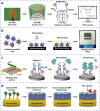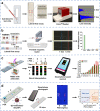Point-of-Care Prostate Specific Antigen Testing: Examining Translational Progress toward Clinical Implementation
- PMID: 37830899
- PMCID: PMC10616866
- DOI: 10.1021/acssensors.3c01402
Point-of-Care Prostate Specific Antigen Testing: Examining Translational Progress toward Clinical Implementation
Abstract
Prostate cancer (PCa) is the second most common male cancer and is attributable to over 375,000 deaths annually. Prostate specific antigen (PSA) is a key biomarker for PCa and therefore measuring patient PSA levels is an important aspect of the diagnostic pathway. Automated immunoassays are currently utilized for PSA analysis, but they require a laboratory setting with specialized equipment and trained personnel. This results in high diagnostic costs, extended therapeutic turnaround times, and restrictions on testing capabilities in resource-limited settings. Consequently, there is a strong drive to develop point-of-care (PoC) PSA tests that can offer accurate, low-cost, and rapid results at the time and place of the patient. However, many emerging PoC tests experience a trade-off between accuracy, affordability, and accessibility which distinctly limits their translational potential. This review comprehensively assesses the translational advantages and limitations of emerging laboratory-level and commercial PoC tests for PSA determination. Electrochemical and optical PSA sensors from 2013 to 2023 are systematically examined. Furthermore, we suggest how the translational potential of emerging tests can be optimized to achieve clinical implementation and thus improve PCa diagnosis globally.
Keywords: biosensors; electrochemical detection; healthcare devices; optical detection; point-of-care testing; prostate cancer; prostate specific antigen; translational progression.
Conflict of interest statement
The authors declare no competing financial interest.
Figures


References
Publication types
MeSH terms
Substances
LinkOut - more resources
Full Text Sources
Medical
Research Materials
Miscellaneous

